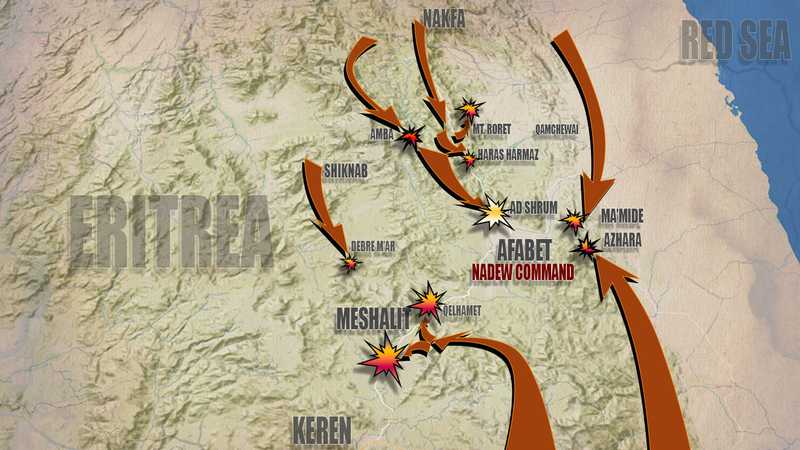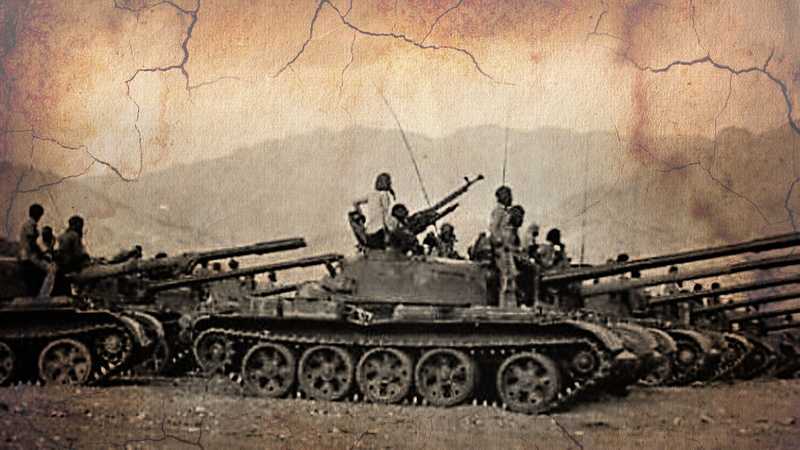EPLF's Battle Plan Against Nadew Command
Between March of 1987 and January of 1988
EPLF's battle plan to completely encircle and annihilate the Ethiopian Army's Nadew Command at the Battle of Afabet
 Map showing the battle plan of EPLF’s military operation to destroy Nadew Command
Map showing the battle plan of EPLF’s military operation to destroy Nadew Command
In a massive military operation, the Eritrean People’s Liberation Front (EPLF) devised an intricate plan to encircle and annihilate the Ethiopian army’s Nadew Command at Afabet.
The battlefield covered a vast area spanning approximately 12,000 square kilometers across a 70km deep and 165km long front. The plan was multi-faceted, involving attacks from six different directions, each with specific objectives and assigned units.
The EPLF army had a total of 10,400 fighters while the Ethiopian army had 18,000 with weapons superiority.
 EPLF freedom fighters’ tank units on the ready
EPLF freedom fighters’ tank units on the ready
The Six Angles of Attack:
1. The Eastern Advance:
Assigned Units:
- Two brigades of the 85th division
- Two battalions of the 87th brigade
- 61st mechanized brigade
- 23rd mechanized brigade
- Parts of the 63rd mechanized brigade
Mission:
- Advance from Qamchewai area through Ma’mide on the eastern part of the front along the left wing, take control of the eastern valleys held by the enemy’s 14th division and its 29th mechanized brigade, and directly advance to Afabet.
2. The Deep Valley Infiltration:
Assigned Units:
- 61st division’s 81st brigade
- A battalion of the 87th brigade
- A heavy infantry company
- A battalion of the 52nd division’s 24th brigade
- 34th and 63rd mechanized brigades
Mission:
- Use the cover of darkness to slip between enemy positions from the deep valleys between Etehaleb’b and Kirf, enter the “Good” River, then turn right to ascend the Roret Mountains. From there, attack enemy forces to the north from the rear, while others head south to attack enemy forces at Haras Harmaz and Mountain Hartetet, destroying the tank, artillery, rifle, and mortar units of the enemy’s 19th division stationed at the Hdai River.
3. The Stealthy Rear and Flank Attack:
Assigned Units:
- Almost all battalions tasked with directly passing undetected through gaps in the enemy positions
- 26th brigade of the 16th division (left flank)
- 11th brigade of the 61st division (right flank)
- Mortar and rifle units
- Units positioned along the Farnello and Kebrtsada lines, including the 34th mechanized brigade
Mission:
- Turn around and attack from the rear and flank the enemy’s 19th and 21st divisions stationed at Amba to Arhatset Aby and the Telkesa River.
4. The Southern Clearance:
Assigned Units:
- 10th brigade of the 70th division
- A battalion from the 71st brigade
- A battalion of heavy infantry
- Some units of the 34th mechanized brigade
Mission:
- Launch from the Shege area, penetrate through Andeb Hasayd, attack and control from the south to clear strategic locations west of Afabet like the Gebgeb River, Globe, and Shiknab rivers, blocking any relief forces from Habero.
5. The Strategic Choke Point at Meshalit:
Assigned Units:
- The entire 52nd division
- A battalion of heavy infantry
Mission:
- Sneak behind enemy lines on the Afabet-Keren road about 30km from Keren, take control of the strategic choke point in the mountain range stretching to Meshalit, preventing any escape from Afabet’s Nadew Ez (Command) and blocking relief forces from Keren. The units started their stealthy trek from behind enemy lines near Mai Medef, passed through Derseney, crossed the Asmara-Keren road at Shindwa, passing through Irairo, Emba, Afluk, and Ans before entering the Afabet-Keren line.
6. The Eastern Flank Attack:
Assigned Units:
- 22nd brigade of the 85th division
- 5 heavy infantry platoons
- Two battalions of the 61st division’s 13th brigade
- Another heavy infantry force
Mission:
- Launch from the forests northern Bahri, approaching Afabet from the east by attacking enemy positions around Azahra and Gadim Halib on the right flank, and joining the friendly units advancing from the main front in the direction of Felket before entering Afabet from the side. This force waited during the first day as other forces pushed the enemy from the south and southeast, carrying out their attack on the second day of the battle.
Conclusion:
The extensive military plan to surround and crush the Nadew Command was a testament to the strategic thinking and meticulous planning of the EPLF.
By dividing the attack into six distinct angles, each with its own specific objectives and assigned units, the EPLF aimed to encircle the enemy army and completely annihilate it.
The coordination and execution of such a complex plan required immense skill, bravery, and determination from the EPLF forces involved.
The Zero Hour was set for the morning hours of March 17, 1988, when the Battle of Afabet to attack and destroy the Nadew Command would commence.
